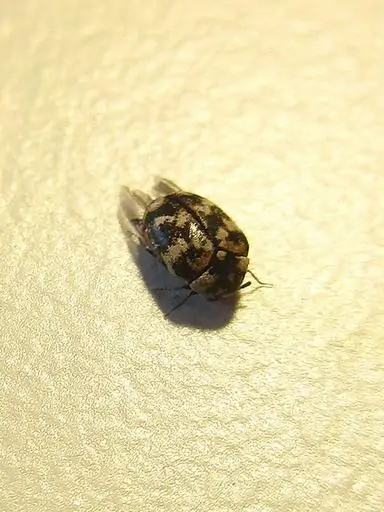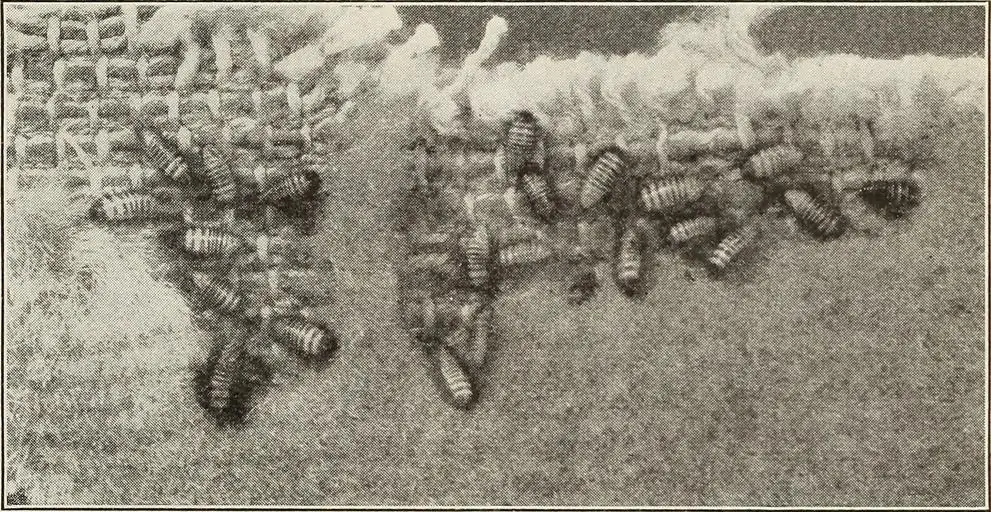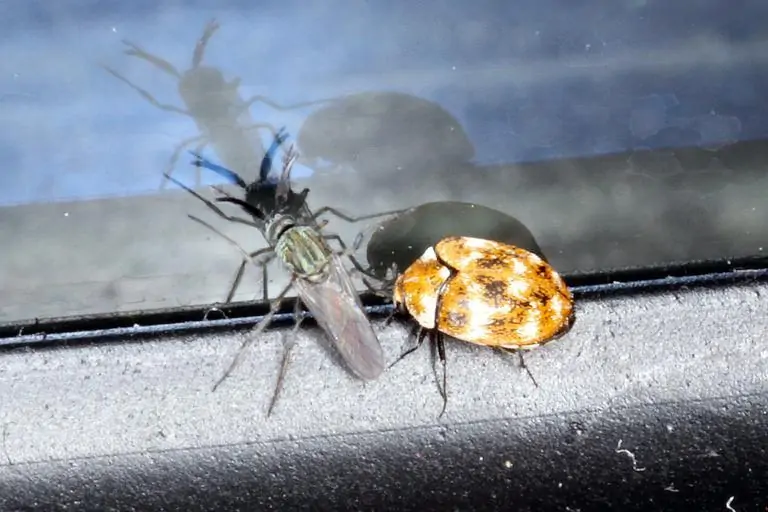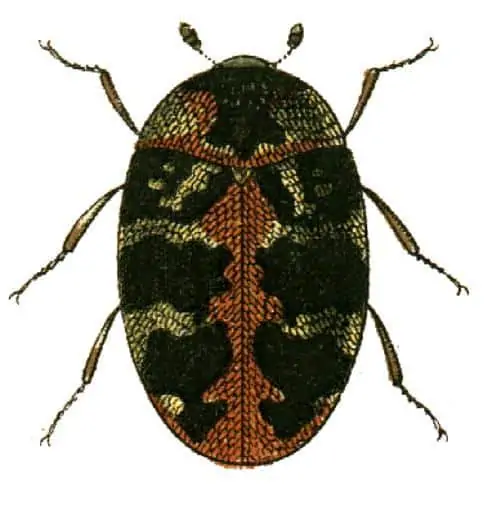There’s no greater fear than the fear of the unknown. At least that’s what people say. We’d have to agree, especially when it comes to dealing with tiny black bugs in your home. If you don’t know what these critters are, you can quickly find your imagination spiraling out of control.
What are these tiny black bugs in my house? Are they ants? Fleas? Bed bugs?
There’s been an uptick of little black bugs creeping and crawling their way around inside American homes, so don’t worry, you’re not alone.
More importantly, you’re likely not dealing with fleas or bed bugs. So, what are these tiny black bugs causing you grief?
Keep reading to find out!
Contents
Tiny Black Bugs At Home – What Are They?
Seeing tiny black bugs in your home can be unnerving, especially if you don’t know what they are.
There are a few types of tiny black bugs that may be getting into your home. Depending on the season, you could be dealing with any of the following pests:
- Fleas
- Ants
- Bed Bugs
- Or Carpet Beetles
While we did just reassure you that you probably were not dealing with fleas or bed bugs, it’s still possible. For that reason, let’s briefly go over how to identify the four most common types of tiny black bugs.
Fleas
Fleas are small, wingless parasites that, while appearing black to the naked eye, are actually tiny brown creatures that rely on hosts to survive. They most commonly feed on wild animals and often unprotected dogs and cats. Once in a while, fleas will attach themselves to people and may even find their way inside after hitching a ride on a pet.
It’s not uncommon to find fleas in your carpets, laundry, curtains and furniture. If you’re worried about the tiny black bugs you’re dealing with potentially being fleas, look out for signs of flea dirt and for discomfort in your pet.
Ants
Ants are typically the easiest insects to identify when it comes to tiny black bugs, though not everyone is 100% sure 100% of the time. Most ants are very small, only growing to be between 2 to 15 mm. Like fleas, ants can also range in color and be a brownish or light red color depending on their species.
To the naked eye, however, most ants appear black. For the most part, ants are harmless to people and pets. That said, there are some species of ants that can be seriously damaging and lead to structural issues and food waste.
If you think you have ants, do your best to find out which types of ants you are dealing with so you can come up with a pest control solution as quickly as possible.
Bed Bugs
Bed bugs are another type of bug that could be to blame for those tiny black bugs you see crawling about.
However, most bed bugs are not typically seen during the day unless you have a very severe infestation.
Bed bugs are also larger, and unless they’ve just had a blood meal, are typically lighter brown. It’s very unlikely that your tiny black bugs are bed bugs, though if you’re not sure it’s a good idea to inspect your home.
Bed bugs can be very sneaky and they procreate quickly, making them especially difficult to get rid of if you’re not proactive.
Carpet Beetles
Last but not least, we have carpet beetles. Of all the tiny black bugs on this list, it’s most likely you’re dealing with carpet beetles.
Some common signs of carpet beetles in your home could include damage, holes, wearing or fraying on rugs or furniture, shed skins from larva, carpet beetle larva themselves, fecal matter (about the size of salt), and adult carpet beetles.
And since you’re most likely dealing with carpet beetles in your home when talking about tiny black bugs, we are going to focus on those.
Tiny Black Bugs At Home – What Is The Black Carpet Beetle?
On the left you see a carpet beetle larva, and on the right you see an adult.
Carpet beetles are small, black beetles that are commonly found inside homes. There are five important types of carpet beetle in the United States that you may find roaming about your residence. The most common include:
- The Varied Carpet Beetle
- The Furniture Carpet Beetle
- And The Black Carpet Beetle
The Varied Carpet Beetle
The Varied Carpet Beetle grows to be around 3 mm in length. It has an interesting pattern of brown, black, tan and sometimes white covering it’s hard exoskeleton. As larva, varied carpet beetles feed on a variety of fibers. This makes them especially problematic for museums and libraries. In homes, they feed on carpets, clothing, furniture and even dead insect collections.
The Furniture Carpet Beetle
As its name suggests, the furniture carpet beetle is a pest that mostly resides in upholstered furniture like couches, chairs, pillows, etc. Growing to be between 2 to 3.5 mm in length, the furniture carpet beetle is easy to see with the naked eye.
Their colors and patterns can vary, and they can be damaging to furniture in large numbers if not taken care of early on.
The Black Carpet Beetle
The black carpet beetle is considered the most common and perhaps the most destructive of these tiny black bugs that you might see in your home. If you’re dealing with tiny black bugs and you’re dealing with carpet beetles, chances are you’re dealing with these guys.
This pest has a voracious appetite and has a propensity for keratin, which is a protein found in feathers and animal hair. They will also eat grains and other plant-based products, dried insects, cereals, fibers and more. They are most damaging in their larval stage, when their appetite is most insatiable.
They are very tiny, so they may not be easy to identify. They can grow to be between 1/8th of an inch and 3/16ths of an inch in length once mature, but as larva they are nearly ½ of an inch long.
Though these tiny black bugs are not dangerous to people or pets, they are highly damaging to household products and can lead to hundreds of dollars in food waste.
But how on earth did you wind up with these tiny black bugs?
Let’s find out!
Why Do I Have Carpet Beetles Inside My House?
Carpet beetles are very common, and they are some of the most common tiny black bugs found inside of homes.
Carpet beetles are unfortunately very common and very easy to wind up with. Although they are most damaging in their larval stage, they are most easily spread during their adult stage.
There are two common ways you may have wound up with carpet beetles in your home.
Infested Products
Many people unwittingly bring carpet beetles into the home by way of infested products. These products could include infested furniture, food, rugs, bedding, curtains, insect collections and more.
Flying Adult Carpet Beetles
Adult carpet beetles have wings and can fly. Like many insects, they are attracted to light and will commonly fly in through open windows around dusk or dawn. Once inside, a single pregnant carpet beetle can lead to an entire infestation.
Understanding The Carpet Beetle Lifecycle
Carpet beetles go through four life stages including egg, larva, pupa and then adulthood. As we’ve mentioned a few times, their larva stage is the most damaging, though adults can be problematic too as they can so easily lead to a serious infestation.
Female carpet beetles can lay between 30 to 100 eggs, which take about 8 to 15 days to hatch. Once the eggs hatch, the larva go about munching on their favorite foods. This often includes a variety of materials.
The larval stage lasts the longest and can range from 60 to 325 days depending on the species. The pupal stage is next and lasts between 10 and 17 days before the critter emerges as an adult carpet beetle, going on to live another 20 to 60 days.
How To Get Rid Of These Tiny Black Bugs – Most Common Methods
Though carpet beetles are not dangerous, they can be quite damaging.
Carpet beetles may be annoying tiny black bugs, but they’re super common in the United States. This means there are plenty of methods you can choose from when it comes to getting rid of them.
Some common methods for how to get rid of tiny black bugs or carpet beetles include:
- Common Insecticides
- Natural Products
- Home Remedies
Common Insecticides
Using insecticides and pesticides for how to get rid of tiny black bugs is one of the most common forms of pest control. Products typically work by using chemical ingredients like permethrin, abamectin, cyfluthrin, bifenthrin and more.
Although insecticides and pesticides have been proven to be an effective form of pest control when it comes to getting rid of tiny black bugs, they are also sometimes controversial.
Many chemical insecticides may be harmful to the environment and pose health risks to children and pets if not used as directed.
That said, when they are used correctly they can get rid of common tiny black bugs and help to keep them away for good.
Natural Products
Natural products and natural insecticides are becoming more and more popular, and many of them work using plant-based ingredients like essential oils. For the most part, experts have found that many natural products and organic insecticides can work just as effectively as chemical insecticides when used as directed.
However, some natural products for how to get rid of tiny black bugs may be more costly and may even need to be reapplied more often than chemical insecticides.
Home Remedies
Many people are trying their hand at DIY pest control. Though this may be a more high-maintenance method for how to get rid of tiny black bugs, it can be an effective one if you have the right ingredients and equipment.
Not sure which method would be right for you? Don’t worry. We have listed some of our favorite options for you.
Keep reading.
Best Insecticides for Getting Rid Of Tiny Black Bugs
If you’re not sure which type of tiny black bug you’re dealing with, the good news is that most insecticides will help get rid of them all.
As we mentioned above, insecticides are not right for every household. You should be especially careful when using chemical insecticides for getting rid of tiny black bugs in the house because you’ll be using these insecticides indoors.
Be sure to always read labels when it comes to pest control products and keep in mind that not all chemical insecticides are available in your region.
And of course, be sure to keep any insecticide out of reach of children and curious pets.
SLA Carpet Beetle Spray
No products found.
With a name like SLA (almost like slay), you already know why we would be listing SLA Carpet Beetle Spray as one of our choices for getting rid of tiny black bugs.
This spray works to kill carpet beetles in all their life stages, but it’s also effective against other common household pests like clothes moths, crickets, roaches, bed bugs, spiders, lice and more.
The spray can be sprayed on a variety of surfaces including natural fibers like cashmere. It will also work for rugs and furniture. Though it does contain chemical ingredients, the product leaves behind a pleasant cedar scent.
Moth Ball Packets
No products found.
Carpet beetles are somewhat like clothes moths in that they have such an appetite for natural fibers and materials. So it should be no surprise that mothballs can work effectively against these tiny black bugs as well.
Mothballs work using the chemical agent naphthalene, which repels and kills pests like carpet beetles, clothes moths and bed bugs. Mothballs can also repel other pests like rodents and lizards.
However, mothballs can be toxic to people and pets. Be cautious of where you place mothballs around your home, including if you place them in pantries, drawers, or closest.
Raid House and Garden Spray
No products found.
Raid is a popular product that makes a wide variety of pest control sprays, but we like this one specifically because it is designed for both indoor and outdoor use. It works not only on carpet beetles, but also many other home invading insects like roaches, spiders and ants.
It will not harm garden plants, though it does contain a chemical ingredient that can be toxic to children and animals. Be sure to read the directions and use this product only as specified. When it’s not in use, store it somewhere safe and out of reach of youngsters.
Best Natural Products For Getting Rid Of Tiny Black Bugs
If you have children or pets in the home, or even if you’d prefer to use natural products, you’re in luck.
Natural products may be the safest choice for anyone with children or pets in the home, but they can also be ideal for those interested in organic gardening in general. Best of all, natural insecticides have been shown for the most part to be just as effective as chemical insecticides when utilized correctly.
With that being said, it’s still important to note that natural pest control products are still pest control products. They can pose some dangers to people and pets and should therefore be used only as directed and kept out of reach of children and animals when not in use.
Diatomaceous Earth Crawling Insect Killer
No products found.
Also known as DE, Diatomaceous Earth is one of the most effective products you can use when it comes to getting rid of carpet beetles naturally. This product is derived from fossilized algae and is totally natural and organic. It is perfectly safe for people and pets, though it is deadly to hard-bodied insects like carpet beetles, roaches, earwigs, ants and more.
It works by penetrating the exoskeleton of the pest, which dehydrates and kills it. Diatomaceous Earth typically comes in a powder form, and the above order even includes a duster to help you reach smaller cracks and crevices when applying it.
Leave the powder down for 24 hours to a few days, then vacuum it up.
Wondercide Indoor Pest Control Spray
No products found.
Wondercide is a spray that uses all natural, plant-based ingredients including peppermint oil and cedarwood oil to repel little black bugs, roaches, spiders, flies, fleas and more. It is a non-toxic alternative to chemical insecticides and is even safe enough to spray in areas where food is stored and prepared.
There is no wait time once this spray is applied, and your kids and pets can be right there in the room while you spray it.
Eco Defense Pest Block
No products found.
Since carpet beetles are tiny black bugs that like to devour materials like clothing and rugs, it makes sense to want a product that works similarly to mothballs. If you’re not interested in using mothballs that contain naphthalene, you might consider trying these pest blocking packets by Eco Defense.
These packets work using essential oils like peppermint oil, cinnamon oil, clove oil and more to deter and repel not only carpet beetles, but also many other pests like clothes moths, roaches, ants, silverfish, spiders, and even rodents and squirrels.
Best of all, these packets are completely natural and nontoxic.
How To Make Your Own Products To Get Rid Of Tiny Black Bugs
Essential oils can be a safe and effective way to help get rid of tiny black bugs.
Wondering if you’ll be able to make your own pest control products for how to get rid of tiny black bugs? Well, you’re in luck. There are actually a few home remedies you can use to manage the tiny black bugs in your home, and many of the ingredients required may already be in your pantry or medicine cabinet.
Essential Oils
Peppermint oil and clove oil have been found to work well against carpet beetles and a variety of other pests. Not only will the smell repel these tiny black bugs, but the oils will kill them on contact.
To make your own essential oil spray for carpet beetles, add 10 to 20 drops of the oil of your choice to two cups of water in a spray bottle. Mix the solution and then spray around your home and on rugs or furniture as needed.
Be careful not to over add oil to the water as this could wind up leaving a stain on your furniture or possessions. For best results, test a small area first before spraying your essential oil spray on larger surfaces.
Rubbing Alcohol
Rubbing alcohol deters carpet beetles and can also kill them on contact if enough of the substance is applied. You can spray rubbing alcohol over surfaces to deter these pests and to prevent pregnant females from laying eggs on said surfaces.
Cedar Oil
Cedar oil can kill carpet beetles in all their life stages, making it a very helpful tool to have on hand when combating them. In adult carpet beetles, cedar oil causes suffocation on contact. In immature carpet beetles and eggs, the oil dissolves them.
Apple Cider Vinegar
We like apple cider vinegar because it can be functional for so many surfaces. You can use it as a natural and safe carpet cleaner, rug cleaner, fabric cleaner and hard-surface cleaner. Best of all, it works as a natural insecticide that can kill carpet beetles on contact and deters them from returning.
Wash Infested Items Carefully On Warm or Hot, Or Consider Dry Cleaning
If you do have infested items, be sure to get them cleaned thoroughly. You can wash them yourself on warm or hot to kill these tiny black bugs, or you can take infested items to the dry cleaner.
Freeze Infested Items
Contrarily, you also have the option of freezing infested items. This works best if you have a larger freezer, though it depends on the size of the items infested. Generally, it can take around 72 hours for freezing to kill tiny black bugs in all their life stages.
Tips On Keeping Tiny Black Bugs Out Of Your House For Good
Getting rid of carpet beetles – or any tiny black bug – means being proactive.
Carpet beetles can be difficult to manage, especially because they are so easily contracted. The good news is that they are not as difficult as many other types of tiny black bugs to get rid of, especially when you follow our above tips and use the right products.
Of course, it’s always easier to be proactive and prevent tiny black bugs than it is to get rid of them. Luckily, we have a few tips and tricks you can follow for not only how to get rid of tiny black bugs, but keep them from returning.
Clean and Vacuum Daily
Cleaning is key when it comes to getting rid of tiny black bugs in the home. Keeping things organized and getting rid of unnecessary debris will also help reduce your chances of dealing with an infestation or, at the very least, allow you to catch one earlier.
If you vacuum consistently, you’ll be able to collect any potential carpet beetles. Just be sure to dispose of the contents in your vacuum bag outside and in a sealed container or inside another sealed bag for disposal.
Refrain From Bringing Second-Hand Furniture In Your Home without Thoroughly Inspecting It
This is a good rule to follow not only to help keep tiny black bugs away, but also other pests like bed bugs. Be sure to inspect and clean any second hand furniture, rugs, curtains, bedding or even toys before bringing these items in your home.
Store Foods In Airtight Containers
Since most carpet beetles also feed on grains and plant-based items, foods like cereals and rice are especially at risk of becoming infested. To prevent this from happening, it’s a good idea to store your pantry foods in airtight containers.
Consider Synthetic Fabrics Over Natural Fabrics
If you remove the pest’s food source, you’ll likely remove the pest. Most carpet beetles feed on organic matter and are highly attracted to items like fur coats, wool rugs, and other naturally made products.
If you want to keep carpet beetles away, consider synthetic products instead.
Use A Year-Round Pest Control
Last but not least, be sure to use a year-round pest control both inside and outside of your home. Remember, plenty of carpet beetle infestations begin when adult carpet beetles fly into homes.
You can prevent this by also keeping windows closed during the seasons when these insects are most active and by staying vigilant.
We hope this has been a helpful guide on tiny black bugs! So you tell us – did we hit the nail on the head? Are you dealing with carpet beetles?
Tell us what you think in the comment section below.
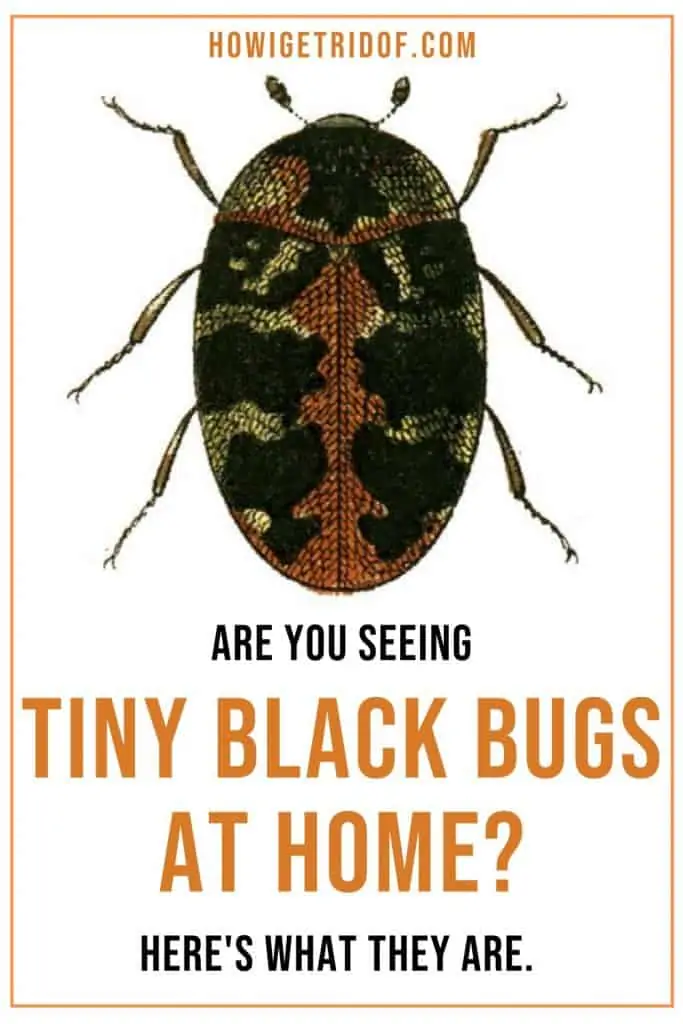

Jack founded our blog after two decades of working in the pest control industry. His vast experience dealing with a wide array of pests allows him to diagnose issues quickly and get to the heart of pest problems quickly and effectively. He has serviced more than 2,000 homes over his career and there is hardly any pest situation that he has not seen before.


